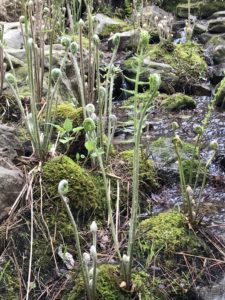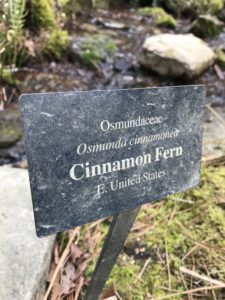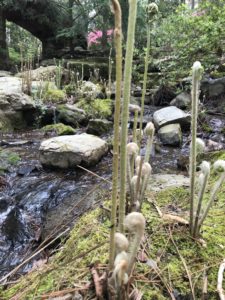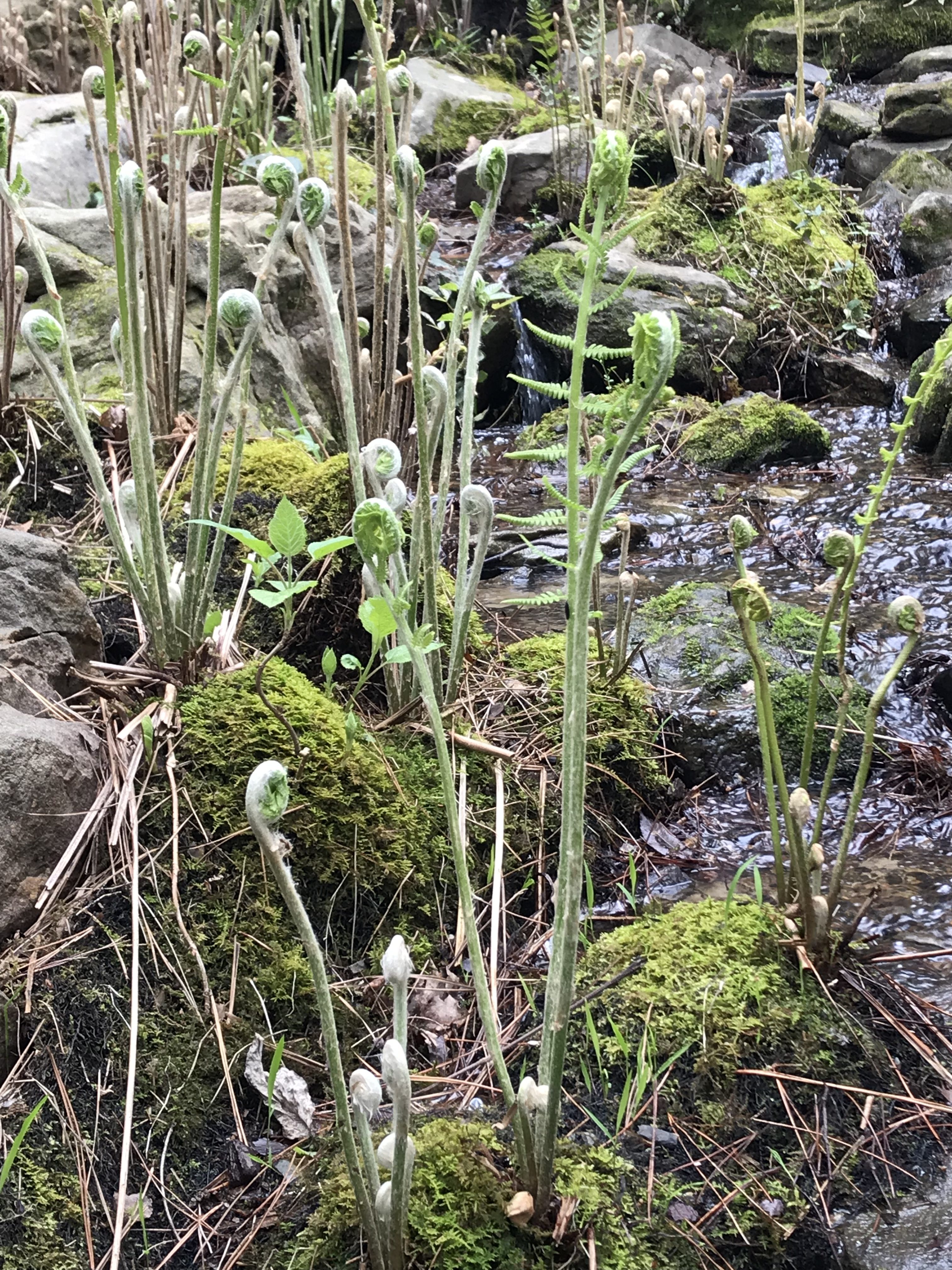 FIDDLEHEAD FERNS ARE THE FIRST TASTE OF THE WILD SPRING – These were photographed by a freshwater spring in Northern Arkansas earlier this week.
FIDDLEHEAD FERNS ARE THE FIRST TASTE OF THE WILD SPRING – These were photographed by a freshwater spring in Northern Arkansas earlier this week.
TODAY’S LESSON: The cool spring weather slowly brings to life the wild fiddlehead fern, which offers the elusive flavor of asparagus and artichokes simultaneously. Today, we will unlock the mysteries of this fabulous vegetable.
WHAT EXACTLY IS A FIDDLEHEAD FERN? Edible fiddlehead ferns are most common from the ostrich and related fern family, which when immature and emerging from the ground appear in the shape of a fiddlehead. Other species also emerge in this same way but considered by some as carcinogenic if consumed in significant quantities. The variety shown here is Cinnamon Ferns.


WHERE DO THEY COME FROM? Fiddlehead ferns grow wild from the northeastern United States to Newfoundland and west through Michigan and into Wisconsin. Maine and Vermont have some of the largest commercial crops because of their cool weather and undeveloped land. They are also abundant in the Ozark Mountains of Arkansas.
WHY DO THEY TASTE SO GOOD? Fiddlehead ferns are gathered exclusively from the wild with their true natural flavor at its best. They taste like a mixture of asparagus, artichokes, green beans with a woodsy mushroom background flavor.
ADVANTAGES: They are high in Vitamins A and C and contain a lot of fiber.
SELECTING YOUR FIDDLEHEADS: Select fresh fiddleheads that are bright green, firm and with tight heads about 1-1/2 inch in diameter. The best heads have the smallest tails or length of extended stems. Some heads may have a brown paper-like coating which is the crown material that the ferns are breaking out of. This material may reflect that they were picked as they emerged, but check to make sure that it is easy to remove. Fiddleheads are best when very fresh so use as soon as you get them.
PREPARING YOUR FIDDLEHEADS: Trim the end of the tail off. Remove the brown membrane from the fiddlehead. Rinse well under cold, running water scrubbing as necessary to dislodge any other material.
THE COOKING BEGINS: Fiddleheads are usually best when blanched first in boiling salted water to soft to al dente, firm to the bite, then finished by sauteing in a little butter or olive oil with aromatics such as garlic, shallots, and onions. Mix in herbs and other seasonings to highlight their natural flavors.
THE SECRET TO THE GRATIN: The chef’s secret to a perfect gratin is to slice the potatoes “paper” thin. This way the potatoes absorb the moisture from the cream and turn it into a luxurious warm almost soft cheese between the layers.
The best way to get the potatoes this thin is to use a mandoline slicer. You can get one at your favorite kitchen store ranging from lifelong investment type made from stainless steel or the economy model made from plastic. Both work fine for this application.After slicing the potatoes use them immediately in the dish. Sitting at room temperature will turn them brown from the starch on the surface. Rinsing them under running cold water to remove the starch will alter your cooking results preventing that “perfect” cheesy texture.
LAYER AWAY: Start by laying in the potatoes, slightly overlapping each other to form a complete layer in the bottom of the baking dish. Spoon a little cream over the potatoes to moisten, seasoning with a little salt and pepper. Distribute the prepared fiddlehead ferns lightly across the layer of potatoes. Repeat with another layer of potatoes, cream, and fiddleheads until all the ingredients are incorporated, topping with a layer of potatoes. Sprinkle the top with Parmesan.
Bake on the lower rack of a preheated 400 degree F. oven until golden and the potatoes are tender, about 45 to 60 minutes. Remove from the oven and allow to cool until just warm on a cake rack. Reheat for about 5 minutes and serve.
TRY YOUR TECHNIQUE: Don’t miss this great gratin that works well with many other vegetables such as artichokes, mushrooms and such. Try FIDDLEHEAD FERN GRATIN to spark up any meal.
FIDDLEHEAD FERN GRATIN Make 8 servings
1 pound fiddlehead ferns, trimmed and cleaned
2 tablespoons unsalted butter
2 tablespoons minced fresh garlic
1 cup diced shallots (substitute the white part of the scallion) few red pepper flakes (optional to your own tastes)
Sea Salt
Freshly ground black pepper
2 tablespoons of chopped parsley
2 tablespoons snipped fresh chives
4 large baking potatoes, peeled and sliced almost paper thin on a mandoline slicer 1-1/2cup heavy cream
1/4 cup Parmesan cheese
Preheat oven to 400 degrees F.
In a large pot of boiling salt water, cook the fiddleheads until al dente, firm but not raw to the bite. Transfer to a colander and drain.
Meanwhile, in a large non-stick skillet, heat the butter over high heat. Add the garlic and cook until softened about 2 minutes. Add the shallots and red pepper flakes, cooking until softened about 3 minutes. Season with salt and pepper to taste. Add the fiddleheads, parsley, and chives, tossing to combine. In a buttered 8″ by 8″ baking dish, place the potatoes in slightly overlapping each other to completely cover the bottom. Spoon a little cream over the potatoes to cover. Distribute about 1/8th of the fiddlehead mixture atop the potatoes. Season with salt and pepper. Repeat the technique layering in the potatoes and the fiddleheads until all the ingredients are incorporated. Top with a sprinkling of Parmesan cheese. Place on the lower rack of the oven cooking until golden brown and the potatoes are tender as checked by the insertion of a skewer which will have no resistance. Remove from the oven and allow to cool until warm on a baking rack. Reheat for about 5 minutes and spoon to serve.
Jimmy Schmidt
